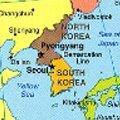The three-year war that made Panmunjom one of the world's most poignant datelines has never ended. A truce was signed here in 1953. Ever since, Korea has remained divided and, technically, still in a state of war. Just east of the former village of Panmunjon is the Joint Security Area, a patch of land about 800 meters in diameter. The intimidating poses struck by the guards and constant surveillance by both sides exemplify the very real tension here.
On the northern side of the military demarcation line is the Korean People's Army. To the south, 750 soldiers of the army of the Republic of Korea and about 50 soldiers from the U.S. Army.
The allies in the DMZ compose the United Nations Command's Joint Security light infantry battalion. U.S. Army Sgt. Robert Juarez, posted at the DMZ as part of that security battalion, says nothing substantial has changed since the Cheonan incident. But there has been one subtle difference.
"We have noticed that the North Koreans have moved to the old style helmets," he said. "It's kind of pretty much a display action. It's just basically a painted helmet that they sit on their heads. It's very similar to the one that the South Korean soldiers wear." Over the decades of the truce there have been hostile incidents here and elsewhere along the DMZ, resulting in military casualties on both sides. That means the forces that are stationed here are always considered to be on high alert.
"We up here are one of the most forwardly deployed units on the Korean peninsula, so we are always on a higher-ready status than anyone else," said Sgt. Juarez.
The South Korean and American forces posted here are not intended to fend off an invasion. Armed with only pistols, as mandated under terms of the truce, their primary mission would be to shepherd to safety U.N. Command Military Armistice personnel, nearby villagers and any visitors who might be present in the DMZ.

